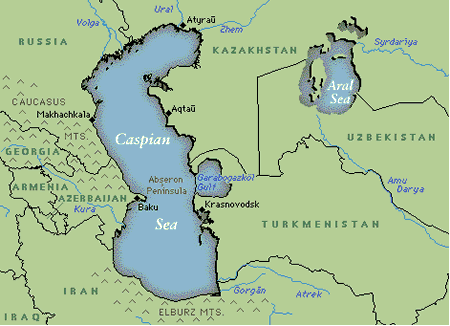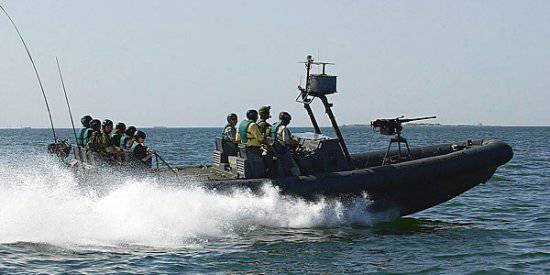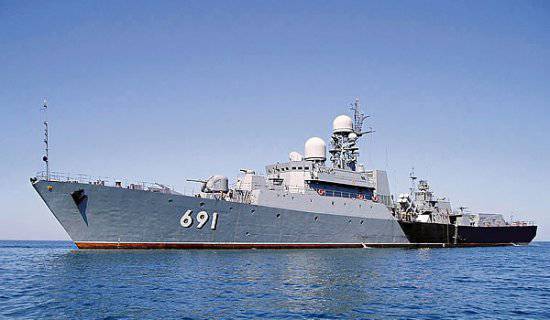United States for the militarization of its neighbors in the Caspian region
 Washington intends to restrain Iran and the Russian Federation, arming its neighbors in the Caspian Sea, in view of the "growing importance of the security of the Caspian Sea in this region rich in oil and gas."
Washington intends to restrain Iran and the Russian Federation, arming its neighbors in the Caspian Sea, in view of the "growing importance of the security of the Caspian Sea in this region rich in oil and gas."This is stated in the US edition of EurasiaNet, referring to sources in the US State Department. The United States intends to support the naval preparations of Azerbaijan, Turkmenistan and Kazakhstan.
In recent years, these countries have sharply increased their preparations in this region, starting a very real arms race. The Azerbaijani Navy inherited from the USSR a pretty good start, they multiplied it and now have naval forces second only to the Russian ones, surpassing Iranian ones.
Kazakhstan and Turkmenistan are creating their own Navy, until recently they had only patrol and border forces, now they are creating full-fledged flotilla with warships.
The publication notes: "The United States will continue to work with the Azerbaijani Navy to increase the security of the Caspian Sea, develop professional military education, expand opportunities to participate in joint peacekeeping operations and help move towards interoperability with NATO ..." In the future, Washington believes that Azerbaijan will be involved in the bloc NATO.
In the Turkmen direction, the Americans want to organize the training of local sailors in English as part of the IMET program. In Kazakhstan, the United States intends to help modernize the marine aviationin particular, US-made helicopters already in its arsenal.
The United States and previously supported these countries, for example, passing them patrol boats.
After the collapse of the USSR, the division of the Caspian Sea has long been and still remains the subject of unresolved disagreements related to the sharing of resources of the Caspian shelf - oil and gas, as well as biological resources. For a long time, negotiations were held between the Caspian states on the status of the Caspian Sea - Azerbaijan, Kazakhstan and Turkmenistan insisted on dividing the Caspian along the median line, and Iran on dividing the Caspian into one-fifth of all Caspian states. The current legal regime of the Caspian was established by the Soviet-Iranian treaties 1921 and 1940. These treaties provide for freedom of navigation throughout the sea, freedom of fishing, with the exception of ten-mile national fishing zones, and a ban on navigation in its waters of vessels flying the flag of non-Caspian states. Negotiations on the legal status of the Caspian are currently ongoing. The Russian Federation has concluded agreements with Kazakhstan on the delimitation of the bottom of the northern part of the Caspian Sea in order to exercise sovereign rights to subsoil use (from July 6, 1998, and its Protocol from May 13, to 2002). There is an agreement with Azerbaijan on the delimitation of adjacent sections of the bottom of the northern part of the Caspian Sea (from September 23 2002). A trilateral Russian-Azerbaijani-Kazakhstan agreement was also signed on the junction point of the delimitation lines of adjacent sections of the Caspian Sea bottom (from 14 in May 2003), which established the geographical coordinates of the dividing lines bounding the bottom areas, within which the parties exercise their sovereign rights in exploration and extraction of mineral resources.
Military preparations of the neighbors of the Russian Federation
Azerbaijan
- The flagship of the Azerbaijani Navy, the Qusar patrol ship (the former Bakinets of the 159A project), after a long modernization, retained two anti-submarine-bombing bombs of RBU-6000. It was strengthened and its artillery weapons. Two paired 76-mm AK-726 artillery mounts added two paired 30-mm AK-230 assault rifles. Anti-submarine potential received and patrol boat Р219 (former rescue project 368U). In addition to the twin 25-mm anti-aircraft installation 2М3М and 14,5-mm machine gun it was equipped with two rocket bombers RBU-1200.
- With the help of the United States, Azerbaijan has created a special-purpose naval unit. The armament of this unit is still composed of ultra-small submarines of the Triton-1M and Triton-2 types, as well as underwater means of movement of the Siren type. Obviously, in recent years, its arsenal has replenished with other special means of production of the NATO countries. In any case, instructors of the US Navy SEAL sabotage and intelligence units work in this center.
- Conducts Baku and active military cooperation with Turkey.
Azerbaijan has RIB-36 boats for the transfer of special forces.
The patrol boat of the project 205P "Tarantula" of the Bokhr of the Red Army of Azerbaijan.
Iran
- Iran has 3 naval bases on the Caspian Sea - Bender-Mehshehr, Bender-Enzeli, Bender-Pahlavi (training). Iran has about 90 ships in the Caspian, including Chinese-made ships equipped with 120 missiles with kilometers. Iran also has the opportunity to increase its military potential 1,5 times in a short time by transferring boats from the Persian Gulf to the Caspian Sea. Iran also announced plans to deploy several helicopter-carrying vessels in the Caspian.
- The second missile destroyer under construction (in fact, this is a corvette) of the Jamaran type will serve in the Caspian. The displacement of this "destroyer" - about 1420 t, and the armament includes anti-ship missiles Noor, artillery installations and a helicopter, capable of providing target designation over long distances.
- Now Iran is building small missile boats of the Peykaap II type. In total, 75 units are planned to be commissioned. With a displacement of less than 14 T, they develop an 52-nodal full speed. Their armament consists of two Chinese-made FL 10 (C-701) anti-ship missiles. The range for the FL 10 is 15-20 km, and the warhead weight is about 30 kg. But, despite the modest characteristics, these missiles with mass use, namely, they are designed for it, can cause a lot of trouble. A part will go to the Caspian Sea, moreover, they are easy to redeploy, with the use of heavy vehicles it takes only a few days.
- It is possible that the appearance of small submarines of the Iranian Navy in the Caspian Sea, whose mass production was mastered with the help of North Korea. According to some sources, one or two mini-submarines of the Ghadir type are already operating in the waters of this sea. Their underwater displacement is about 120 t, length - 29 m, body width - 2,75 m. The main armament - torpedoes. They can transport combat swimmers. The diving range of such submarines under the snorkel is 1200 miles, that is, more than enough for the Caspian Sea.
It is planned to build 75 small rocket boats of the Peykaap II type.
Missile boat type Sina Navy Iran.
Kazakhstan
- Kazakhstan is engaged in building a naval base in Aktau, and Kazakh cadets are studying abroad, mainly in Russia and in Turkey. In addition, small groups of Kazakh cadets are located in the United States, Germany, India and Pakistan.
- Before 2004, Astana had only border boats and one patrol ship; later, Ukraine purchased several Grif-type boats and 4 patrol boats of the Kalkan type.
- In 2006, South Korea, 3 artillery boats of the Sea Delphin type were transferred to Kazakhstan.
- In 2010, the USA transferred four amphibious boats to Kazakhstan on a gratuitous basis under the five-year plan for cooperation between the ministries of defense of Kazakhstan and the United States.
- Astana plans to purchase several (six) rocket-artillery ships of the 21632 “Tornado” project.
“Two Super Super Leopard missile boats were ordered from the Russian Federation, laid down at the Zenit plant in 2010.
- An agreement was reached on training on the basis of the reconnaissance and sabotage center (military unit 641) of the Azerbaijani Navy personnel of the marine special forces of Kazakhstan, given that the Azerbaijani combat swimmers were trained in NATO standards.
Turkmenistan
- There is a creation of a naval base in the port of Turkmenbashi, they are planning to create a 2015 year. A naval training institute will also be created here.
- In 2002, new patrol boats purchased from Ukraine, mainly the Kalkan-M and Grif-T, entered service with the coast guard forces.
- Iran delivered 2003 to Turkmenistan for a long-term lease of seven coast guard boats and one destroyer.
- As part of cooperation with the US Department of Defense, a Point Jackson class patrol boat entered the armament of the Turkmen Navy.
- In December 2009 of the year it became known that the Turkmen Navy received two Russian Sobol patrol boats.
- In 2008, Turkmenistan purchased three patrol vessels with remote-controlled missiles in Russia, as well as two smaller patrol vessels.
- In Russia, two Molniya-type rocket boats of the 12418 project were ordered. Each of them will carry 16 anti-ship missiles of the Uran-E complex with a firing range of up to 130 km. That is, these ships will surpass Iran’s Sina type RCA by four times in shock power, and the Russian patrol ship Tatarstan by two. In the future, these boats can get X-35UE Super-Uran missiles with a doubled firing range and a combined guidance system, which allows them to hit targets with high accuracy.
- In 2011, I bought two high-speed patrol boats from Turkey worth 55 million euros from Turkey. Attached to the ships is a 40-millimeter cannon made by the Italian defense company Oto Melara.
What is Russia?
The Russian Caspian flotilla is by far the most powerful military unit in the region, taking into account coastal units. For example, a separate coastal missile division (OBDS) joined the Caspian Flotilla in Kaspiysk. Additional positions for coastal-launched missiles are equipped on a hill near the city of Izberbash, that is, near the area of offshore oil fields and near the border with Azerbaijan. The OBRD in Kaspiysk is armed with anti-ship missiles of the onshore “Ball” complex, whose range is 130 km. That is, missiles can destroy naval targets located in the middle of the Caspian Sea. Our flagship - patrol rocket ship "Tatarstan" - is equipped with Uran anti-ship missiles, being the most powerful ship in the Caspian Sea.
At the Zelenodolsk plant them. A.M. Gorky for the Caspian Flotilla is building the 21631 ("Buyan-M") rocket-artillery ship "Grad Sviyazhsk", five ships in the series are planning, but it is not known whether they will all go to the Caspian Sea. In the Green Share, with 1994, they are building and will not complete the SKR Dagestan project 11661, it is of the same type as the flagship of the Tatarstan CF. In addition, small artillery ships of the 21630 “Buyan” project - “Volgodonsk” and “Makhachkala” are being built at the Almaz plant.
According to military expert Konstantin Sivkov:
"For the US, the Caspian plays an extremely significant role in their geopolitics. Now they are trying to gain a foothold in this region at any cost. It is not only about controlling local energy resources. It is beneficial for the States to implement subsequent aggressive plans for China, Russia and Iran. And the stake here is on Azerbaijan, with the political elite of which the United States has established a particularly close relationship. By drawing this and the rest of the region’s countries into military-technical cooperation, America thereby gets a greater opportunity to influence and their policy. If it fully supplies everything necessary for the fleets of these countries, it will control their military power, and if someone does not behave in the way Uncle Sam wants, he will be threatened with refusing to supply parts and ammunition And even if necessary, they will turn off electronics from satellites. As a result, the military equipment available in the Caspian countries will become just rubbish.
... Washington can use the Aliyev regime in the same scenario, which he tested in 2008 against Moscow with Saakashvili’s hands, in the Iranian direction. In recent years, relations between Baku and Tehran, to put it mildly, left much to be desired. Iran fears subversive activities by the Azerbaijani special services in Iranian Azerbaijan. The Persians are equally concerned about the ambitions of Azerbaijanis for the oil and gas resources of the Caspian Sea. In past years, the Azerbaijani Navy has repeatedly taken provoking demonstrative actions against Iran.
Therefore, with a certain scenario, the United States may try to use Azerbaijan against the Islamic Republic as they did with Georgia in relation to Russia. However, the further strengthening of Baku’s power at sea cannot help but concern another American partner in the Caspian Sea, Turkmenistan, which also has disputes with Azerbaijan over control over a number of oil and gas fields. ”
The question is why it was necessary to abandon Central Asia and the South Caucasus in 1991, now the Caspian would, in practice, be our lake, with the inclusion of the coast of Iran. And Iran may well be our strategic partner. And the United States with other Western "players", and China, which in recent years has been increasingly intensified in Central Asia, would be out of business.
The guard ship "Tatarstan" is the flagship of the Caspian flotilla of the Russian Navy.





Information